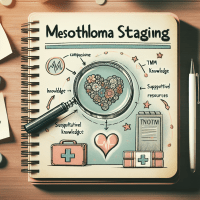Asbestos Mesothelioma Link Facts: A Compassionate Guide
As someone who has dedicated my career to supporting patients and families affected by mesothelioma, I believe it is crucial to share factual, compassionate information about the connections between asbestos exposure and this devastating disease. In this guide, I draw upon my personal and professional experiences as an oncology patient educator and advocate. I aim to provide clear insights on the mesothelioma journey by explaining the correlations behind asbestos exposure, discussing the medically established stages and treatment approaches, and offering resources for emotional support.

This article is designed to be a resource that blends scientific accuracy with heartfelt guidance. The facts presented here about asbestos mesothelioma link facts are supported by authoritative sources such as the National Cancer Institute (NCI), the American Cancer Society, and the Mesothelioma Applied Research Foundation. It is my sincere hope that this guide not only informs but also provides comfort and direction to those navigating this difficult terrain.
Understanding Mesothelioma and Asbestos Exposure
Mesothelioma is a rare, aggressive cancer typically affecting the lining of the lungs, abdomen, or heart. It is primarily linked to asbestos exposure, which has long been known to cause serious health concerns. As someone who has seen firsthand the challenges faced by patients diagnosed with mesothelioma, I feel compelled to share both the medical facts and the lived human experiences behind this disease.
What is Mesothelioma?
Mesothelioma develops in the mesothelial cells that form the protective lining of our internal organs. While the occurrence of this cancer remains relatively uncommon, its prognosis is often grave. Understanding its symptoms—such as chest pain, shortness of breath, and chronic cough—is vital for early detection and treatment. Moreover, the awareness of mesothelioma symptoms contributes to timely medical intervention and improved care outcomes.
The Link to Asbestos
One must understand that the roots of mesothelioma usually lie in harmful exposure to asbestos, a naturally occurring mineral once celebrated for its heat resistance and strength. However, exposure to asbestos fibers can lead not only to mesothelioma but also other asbestos-related diseases, including lung cancer and asbestosis. In my years of working with patients, I have seen how legally and medically challenging the journey can be, especially when patients pursue asbestos lawsuits and seek compensation while grappling with their health. It is essential to recognize the gravity of asbestos exposure leading to mesothelioma and the importance of early detection.
- Asbestos Exposure: Persistent contact with asbestos fibers can be through occupational hazards or environmental mishaps.
- Mesothelioma Symptoms: Symptoms often manifest years after exposure, making them difficult to detect initially.
- Legal and Emotional Challenges: Many patients later face the complexities of mesothelioma compensation claims process and legal help for asbestos exposure victims.
Staging and Treatment Options for Mesothelioma
In addressing mesothelioma, one of the foremost steps is determining its stage. The staging of mesothelioma is crucial as it directly influences treatment options and potential outcomes. I have collaborated with several treatment centers and witnessed the evolution of mesothelioma treatment options that include surgery, chemotherapy, and radiation therapy. My approach to discussing these options is grounded in compassion, keeping in mind the stressful decisions families must make.
Mesothelioma Staging and the Role of Diagrams
Having a clear, medically accurate diagram is an invaluable tool for both patients and caregivers to better understand the progression of mesothelioma. Below is a diagram designed to illustrate the staging and potential treatment options:

This diagram outlines the stages from early localized disease to advanced metastatic spread. In early stages, treatment might involve surgical intervention alongside adjuvant therapies such as chemotherapy and radiation. As the disease progresses, the focus may shift towards palliative care to improve the patient’s quality of life and manage symptoms effectively. Each patient’s journey is unique, and treatment strategies are adapted to individual circumstances.
Exploring Current Treatment Centers and Options
Current treatment centers are making significant strides in managing mesothelioma. When searching for mesothelioma treatment centers near me, many patients find hope in multidisciplinary approaches, including clinical trials focusing on innovative therapies. Comprehensive care planning, which often involves a team of oncologists, surgeons, and palliative care specialists, is essential in developing personalized treatment regimens for mesothelioma patients.
Emotional and Practical Support for Patients
Navigating a mesothelioma diagnosis is an emotionally taxing journey. My personal and professional interactions with patients have taught me that emotional support is as crucial as medical treatment. Many patients and caregivers benefit from joining asbestos-related cancer support groups where they can share experiences and find strength in community bonds.
Finding Guidance and Community
The road to recovery is often accompanied by moments of deep uncertainty and emotional hardship. I always encourage patients to explore multiple dimensions of support, including counseling and support groups. For those seeking legal guidance, it is advisable to pursue legal help for asbestos exposure victims after you have fully absorbed and understood the available treatment and support options.
You can also visit our internal resource page on Mesothelioma Treatment Options to get updated information on advancements in care. Additionally, our section on Emotional Support Resources for Mesothelioma Caregivers offers tips and tactics for managing the emotional toll of this disease.
Practical Steps and Professional Advice
I have often advised that a proactive approach is key: regular check-ups, adhering to treatment plans, and keeping an open dialogue with your healthcare provider can all contribute positively to managing the condition. When dealing with the aftermath of asbestos exposure, being vigilant about new or worsening symptoms is paramount. Early detection remains the cornerstone of effective management. Remember, these strategies and tips have been tried, tested, and refined over years of dedicated patient care.
For many, the path forward involves not only treatment but also legal and financial considerations regarding asbestos lawsuits. While this is an important aspect, I encourage all readers to first focus on gathering comprehensive medical information and securing the support of qualified healthcare professionals.
A Transparent Look at Site Support
In the spirit of full transparency, I want to note that this website occasionally shares support information related to both medical and legal aspects of mesothelioma care. Our goal is to provide unbiased, compassionate information first, with any commercial services clearly disclosed after all relevant content is provided. Your trust is paramount, and we strive to ensure that every piece of information is both educational and empathetic.
Conclusion: Empowering Informed Choices
In closing, I hope that this detailed exploration of the asbestos mesothelioma link facts, mesothelioma staging, and the spectrum of treatment options serves as a useful resource for you. A mesothelioma diagnosis is a life-changing event that brings uncertainty and fear, but it also opens up avenues for community support and professional advice. By understanding the connection between asbestos exposure and mesothelioma, you can make informed decisions on your path to management and recovery.
Remember, every patient’s journey is unique, and while the road may be challenging, the availability of comprehensive, multidisciplinary care offers hope. Whether you are seeking further information on treatment options or looking for a supportive community to help manage the emotional and legal challenges, you are not alone in this fight against mesothelioma.
For more detailed discussions on treatment innovations and community support, please revisit our internal pages and trusted resources mentioned throughout this article. Together, as a compassionate community, we can turn the tide against mesothelioma and improve the lives of those it touches.






